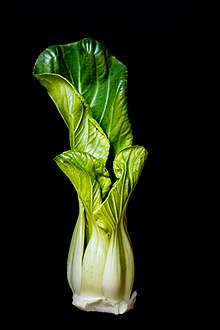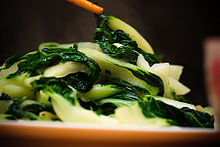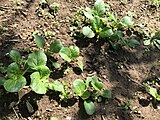Bok choy: Difference between revisions
No edit summary |
Tag: Reverted |
||
| Line 47: | Line 47: | ||
==Nutritional value== |
==Nutritional value== |
||
{{nutritionalvalue | name=Bok choy, raw<br/>(chinensis, <!--spelled pak choi here unlike rest of article because that's how USDA website spells it.-->pak choi) | kJ= |
{{nutritionalvalue | name=Bok choy, raw<br/>(chinensis, <!--spelled pak choi here unlike rest of article because that's how USDA website spells it.-->pak choi) | kJ=52 | protein=1.5 g | fat=0.2 g | carbs=2.2 g | fiber=1.0 g |water=95.3 g| sodium_mg=65 | calcium_mg=105 | iron_mg=0.80 | magnesium_mg=19 | potassium_mg=252|manganese_mg=0.16|vitC_mg=45 | betacarotene_ug=2681 | vitA_ug=243 | vitK_ug=46|thiamin_mg=0.04|riboflavin_mg=0.07|niacin_mg=0.5|pantothenic_mg=0.09|vitB6_mg=0.19|folate_ug=66|right=1 | note=[https://ndb.nal.usda.gov/ndb/foods/show/2894?fgcd=&man=&lfacet=&count=&max=35&sort=&qlookup=chinese+cabbage&offset=&format=Full&new=&measureby= Link to Full Report in USDA Nutrient Database]}} |
||
See the table for the nutritional content of bok choy. The raw vegetable is 95% water, 2% [[carbohydrates]], 1% [[protein]] and less than 1% [[fat]]. In a {{convert|100|g|oz|abbr=off|adj=on|frac=2}} reference serving, raw bok choy provides 54 kilojoules (13 food [[calorie]]s) of [[food energy]] and is a rich source (20% or more of the [[Daily Value]], DV) of [[vitamin A]] (30% DV), [[vitamin C]] (54% DV) and [[vitamin K]] (44% DV), while providing [[folate]], [[vitamin B6]] and [[calcium]] in moderate amounts (10–17% DV). |
See the table for the nutritional content of bok choy. The raw vegetable is 95% water, 2% [[carbohydrates]], 1% [[protein]] and less than 1% [[fat]]. In a {{convert|100|g|oz|abbr=off|adj=on|frac=2}} reference serving, raw bok choy provides 54 kilojoules (13 food [[calorie]]s) of [[food energy]] and is a rich source (20% or more of the [[Daily Value]], DV) of [[vitamin A]] (30% DV), [[vitamin C]] (54% DV) and [[vitamin K]] (44% DV), while providing [[folate]], [[vitamin B6]] and [[calcium]] in moderate amounts (10–17% DV). |
||
Revision as of 06:54, 5 July 2022
| bok choy | |
|---|---|
 Brassica rapa chinensis, called "bok choy" in the United States | |
| Species | Brassica rapa |
| Cultivar group | Chinensis |
| Origin | China, 5th century AD[1] |
Bok choy (American English, Canadian English, and Australian English), pak choi (British English) or pok choi (Brassica rapa subsp. chinensis) is a type of Chinese cabbage, used as food. Chinensis varieties do not form heads and have green leaf blades with lighter bulbous bottoms instead, forming a cluster reminiscent of mustard greens. It has a flavor between spinach and water chestnuts but is slightly sweeter, with a mildly peppery undertone. The green leaves have a stronger flavor than the white bulb.[2]
Chinensis varieties are popular in southern China, East Asia, and Southeast Asia. Being winter-hardy, they are increasingly grown in Northern Europe. Now considered a subspecies of Brassica rapa, this group was originally classified as its own species under the name Brassica chinensis by Carl Linnaeus.[citation needed] They are a member of the family of Brassicaceae or Cruciferae, also commonly known as the mustards, the crucifers, or the cabbage family.
Spelling and naming variations
| Cooked bok choy | |
|---|---|
 | |
| Chinese name | |
| Chinese | 青菜, 小白菜 |
| Hanyu Pinyin | qīngcài, xiǎobáicài |
| IPA | [tɕʰíŋ.tsʰâɪ], [ɕjàʊ.pǎɪ.tsʰâɪ] |
| Romanization | tsching tsae |
| Cantonese and Southern Min name | |
| Chinese | 白菜 |
| Yale Romanization | baahk choi |
| Jyutping | baak6 coi3 |
| IPA | [pàːk tsʰɔ̄ːy] |
| Hokkien POJ | pe̍h-chhài or pe̍eh-chhài |
| Korean name | |
| Hangul | 청경채 |
| Hanja | 靑莖菜 |
| Revised Romanization | cheonggyeongchae |
| Japanese name | |
| Kanji | 青梗菜 |
| Katakana | チンゲンサイ |
| Romanization | chingensai |
Other than the ambiguous term "Chinese cabbage", the most widely used name in North America for the chinensis variety is simply bok choy (Cantonese for "white vegetable") or siu bok choy (Cantonese, for "small white vegetable"; as opposed to dai bok choy meaning "big white vegetable" which refers to the larger Napa cabbage). It can also be spelled pak choi, bok choi, and pak choy. In the UK and South Africa, the term pak choi is used. Less commonly, the descriptive English names Chinese chard, Chinese mustard, celery mustard, and spoon cabbage are also employed.
In Australia, the New South Wales Department of Primary Industries has redefined many transcribed names to refer to specific cultivars. In addition, they have introduced the word buk choy to refer to a specific kind of cabbage distinct from pak choy.[3][4]
In Mandarin Chinese, the common name is 青菜 qing cai ("green vegetable")[5] or 小白菜 xiao bai cai ("small white vegetable"). Although it is simply called 白菜 baak choi ("white vegetable") in Cantonese, the same characters pronounced bai cai by Mandarin speakers are preferably used as the name for Napa cabbage.[6]
What is labelled Bok Choy may come in 2 forms: white bok choy (Chinese: 奶白菜; lit. 'milky white vegetable'[7]) or Shanghai bok choy (Chinese: 上海青; lit. 'Shanghai green'). White bok choy is usually more expensive and has a dark crinkly colored leaves and stem portions that are white and crisp texture that is more suitable to Cantonese style cooking, stir fries, and simple or raw preparations.[8] Shanghai bok choy has greater availability in most American markets, and has mild-tasting spoon-shaped leaves that are lighter green with stems that are jade green instead of white. The texture of Shanghai bok choy is less crisp, and it gets slimy if overcooked, but otherwise can often be substituted for white bok choy.[9]
Culinary use
Bok choi cooks in 2 to 3 minutes by steaming, stir-frying, or simmering in water (8 minutes if steamed whole). The leaves cook more quickly than the stem. It is used in similar ways to other leafy vegetables such as spinach and cabbage.[10]
Nutritional value
| Nutritional value per 100 g (3.5 oz) | |||||||||||||||||||||||||||||||||||||||||||
|---|---|---|---|---|---|---|---|---|---|---|---|---|---|---|---|---|---|---|---|---|---|---|---|---|---|---|---|---|---|---|---|---|---|---|---|---|---|---|---|---|---|---|---|
| Energy | 52 kJ (12 kcal) | ||||||||||||||||||||||||||||||||||||||||||
2.2 g | |||||||||||||||||||||||||||||||||||||||||||
| Dietary fiber | 1.0 g | ||||||||||||||||||||||||||||||||||||||||||
0.2 g | |||||||||||||||||||||||||||||||||||||||||||
1.5 g | |||||||||||||||||||||||||||||||||||||||||||
| |||||||||||||||||||||||||||||||||||||||||||
| Other constituents | Quantity | ||||||||||||||||||||||||||||||||||||||||||
| Water | 95.3 g | ||||||||||||||||||||||||||||||||||||||||||
| †Percentages estimated using US recommendations for adults,[11] except for potassium, which is estimated based on expert recommendation from the National Academies.[12] | |||||||||||||||||||||||||||||||||||||||||||
See the table for the nutritional content of bok choy. The raw vegetable is 95% water, 2% carbohydrates, 1% protein and less than 1% fat. In a 100-gram (3+1⁄2-ounce) reference serving, raw bok choy provides 54 kilojoules (13 food calories) of food energy and is a rich source (20% or more of the Daily Value, DV) of vitamin A (30% DV), vitamin C (54% DV) and vitamin K (44% DV), while providing folate, vitamin B6 and calcium in moderate amounts (10–17% DV).
Toxic effects
Bok choy contains glucosinolates. These compounds have been reported to prevent cancer[citation needed] in small doses, but, like many substances, can be toxic to humans in large doses, particularly to people who are already seriously ill. In 2009, an elderly diabetic woman who had been consuming 1 to 1.5 kilograms (2 lb 3 oz to 3 lb 5 oz) of raw bok choy per day in an attempt to treat her diabetes developed hypothyroidism for reasons relating to her diabetes,[citation needed] resulting in myxedema coma.[13] According to the case study published by her treating physicians, raw bok choy releases an enzyme which can inhibit the uptake of iodine when eaten in large amounts over extended periods.[14]
History
This section needs expansion. You can help by adding to it. (April 2022) |
Bok choy evolved in China, where it has been cultivated since the 5th century AD.[1]
Gallery
-
Young Bok Choy plants in garden
-
Bok choy
-
white bok choy
-
Shanghai bok choy
-
B. rapa chinensis
-
B. rapa chinensis has yellow flowers
See also
References
- ^ a b Sanderson, Helen; Renfrew, Jane M. (2005). Prance, Ghillean; Nesbitt, Mark (eds.). The Cultural History of Plants. Routledge. p. 115. ISBN 0415927463.
- ^ "What Does Pak Choi Taste Like?". Thrive Cuisine. 2 March 2019. Retrieved 13 December 2021.
- ^ "Help is on the way for consumers confused by the wide array of Asian vegetables on sale". 2009-10-22. Archived from the original on 2007-08-20. Retrieved 2011-09-08.
- ^ "Asian vegetable names" (PDF). Archived (PDF) from the original on 2006-10-30.
- ^ "Brassica rapa var. chinensis in Flora of China". efloras.org. Retrieved 2022-04-28.
- ^ "Brassica rapa var. glabra in Flora of China". efloras.org. Retrieved 2022-04-28.
- ^ 饶璐璐 (1999). "含微量元素硒的奶白菜". 中国食品 (17) – via 知网.
- ^ "Ingredient Spotlight: Shanghai Bok Choy". 5 October 2011.
- ^ "Regular vs. Shanghai Baby Bok Choy | Cook's Illustrated".
- ^ "Pak choi". BBC Good Food. Retrieved 2 February 2022.
- ^ United States Food and Drug Administration (2024). "Daily Value on the Nutrition and Supplement Facts Labels". FDA. Archived from the original on 2024-03-27. Retrieved 2024-03-28.
- ^ National Academies of Sciences, Engineering, and Medicine; Health and Medicine Division; Food and Nutrition Board; Committee to Review the Dietary Reference Intakes for Sodium and Potassium (2019). Oria, Maria; Harrison, Meghan; Stallings, Virginia A. (eds.). Dietary Reference Intakes for Sodium and Potassium. The National Academies Collection: Reports funded by National Institutes of Health. Washington, DC: National Academies Press (US). ISBN 978-0-309-48834-1. PMID 30844154. Archived from the original on 2024-05-09. Retrieved 2024-06-21.
- ^ Rabin, Roni Caryn (2010-05-24). "Regimens: Eat Your Vegetables, but Not Too Many". The New York Times. Retrieved 2010-06-03.
- ^ Chu, Michael; Seltzer, Terry F. (May 20, 2010). "Myxedema Coma Induced by Ingestion of Raw Bok Choy". New England Journal of Medicine. 362 (20): 1945–1946. doi:10.1056/NEJMc0911005. PMID 20484407.
External links
 Media related to Brassica rapa subsp. chinensis at Wikimedia Commons
Media related to Brassica rapa subsp. chinensis at Wikimedia Commons Bok Choy at the Wikibooks Cookbook subproject
Bok Choy at the Wikibooks Cookbook subproject






